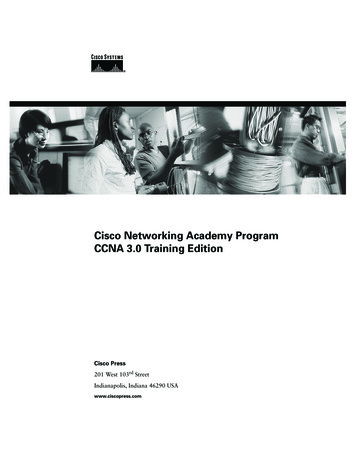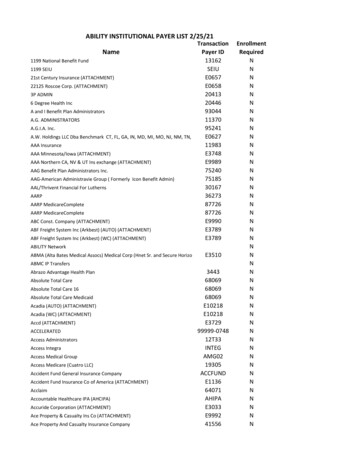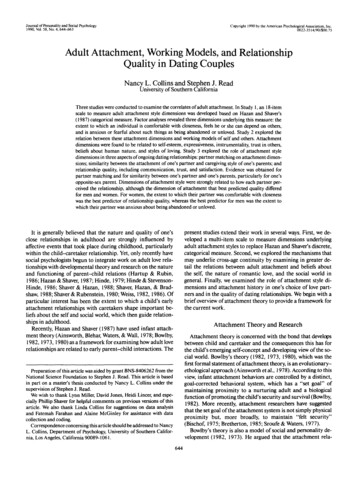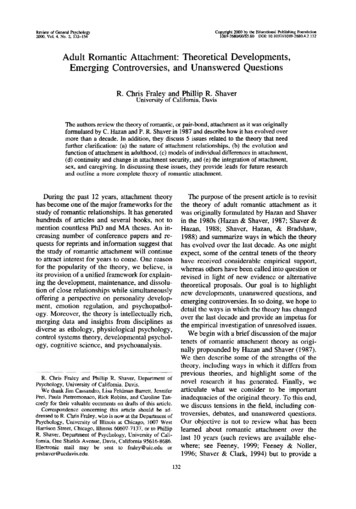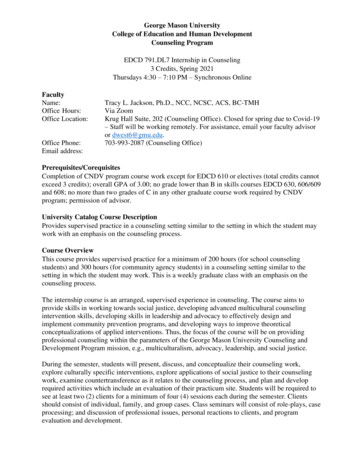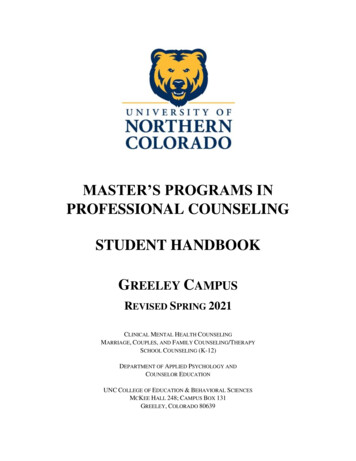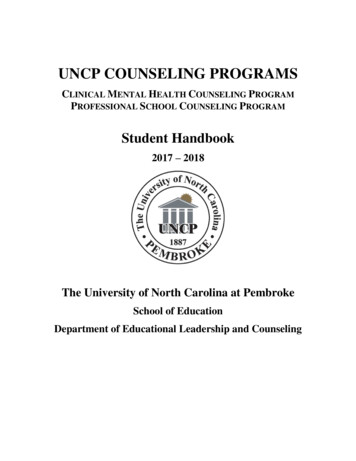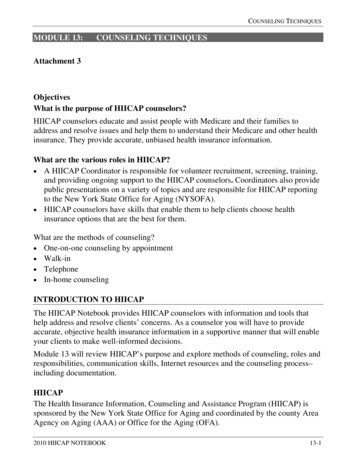
Transcription
COUNSELING TECHNIQUESMODULE 13:COUNSELING TECHNIQUESAttachment 3ObjectivesWhat is the purpose of HIICAP counselors?HIICAP counselors educate and assist people with Medicare and their families toaddress and resolve issues and help them to understand their Medicare and other healthinsurance. They provide accurate, unbiased health insurance information.What are the various roles in HIICAP? A HIICAP Coordinator is responsible for volunteer recruitment, screening, training,and providing ongoing support to the HIICAP counselors. Coordinators also providepublic presentations on a variety of topics and are responsible for HIICAP reportingto the New York State Office for Aging (NYSOFA). HIICAP counselors have skills that enable them to help clients choose healthinsurance options that are the best for them.What are the methods of counseling? One-on-one counseling by appointment Walk-in Telephone In-home counselingINTRODUCTION TO HIICAPThe HIICAP Notebook provides HIICAP counselors with information and tools thathelp address and resolve clients’ concerns. As a counselor you will have to provideaccurate, objective health insurance information in a supportive manner that will enableyour clients to make well-informed decisions.Module 13 will review HIICAP’s purpose and explore methods of counseling, roles andresponsibilities, communication skills, Internet resources and the counseling process–including documentation.HIICAPThe Health Insurance Information, Counseling and Assistance Program (HIICAP) issponsored by the New York State Office for Aging and coordinated by the county AreaAgency on Aging (AAA) or Office for the Aging (OFA).2010 HIICAP NOTEBOOK13-1
COUNSELING TECHNIQUESPrograms across New York State vary by specific services offered, number ofvolunteers, and level of activity. However, since each participates under the New YorkState Office for Aging HIICAP umbrella, they have some very important commoncharacteristics.HIICAP is DynamicHIICAPs are, by definition, dynamic. Because of the changing nature of governmentprograms, health insurance and the health care industry (rules, processes, procedures,and costs), HIICAPs must keep apprised of these changes in order to provide accurate,timely, and objective information to consumers.This means that HIICAP Coordinators must keep their information current and conveythat information to counselors through simplified materials, in-service training sessionsand practice.FlexibleHIICAPs gain considerable strength in their ability to remain flexible to their localcommunity’s needs. The program and its volunteers generally reflect the cultural,ethnic, economic and geographic diversity of the community they serve. Coordinatorsand counselors develop problem-solving skills and educational materials to address theirclients’ most prevalent concerns while materials available from CMS and other nationalresources can lack that local “flavor.”In addition, HIICAPs can respond quickly and effectively to emerging local problems orconcerns regarding changing legislation, questionable insurance sales practices, orincreasing costs of services and policies, for example.EmpoweringEmpowering consumers to make informed decisions and take appropriate action on theirown behalf speaks to the mission of the HIICAP program.This program–while saving consumers hundreds of thousands of dollars each year–provides consumers with something even more valuable: Confidence. Confidencegained by having the information and assistance they need to master this complex–andunavoidable–aspect of life.Peer counselors can provide an added benefit of serving as a positive role model fortheir clients. Peer counselors communicate a subtle but powerful message to clients: If Ican learn and master this, so can you! And HIICAP clients know that they can turn totheir local HIICAP counselor for further assistance if they encounter more problemsalong the way.2010 HIICAP NOTEBOOK13-2
COUNSELING TECHNIQUESCommitmentBecoming a part of HIICAP demands a certain level of commitment on the part of allconcerned: the coordinator, the counselor, and even the client.To be effective, this service requires that participants make the commitment of time andeffort necessary to learn, apply, and follow-up as needed on the information provided.In this program, a mediocre effort will most certainly produce mediocre anddisappointing–even harmful–results.A meaningful effort will produce its own significant reward: grateful and empoweredclients who may be better off financially and, for the counselors, a sense of well beingthat comes from knowing that they’ve made a positive difference in someone’s life.In addition, HIICAP counselors gain special status among peers for knowledge andskills acquired through the program. All this, of course, reflects positively upon theHIICAP Coordinator and sponsoring Area Agency on Aging.Cost-EffectivenessRelative to other community services, HIICAPs have the potential to be incredibly costeffective because they rely primarily on volunteer counselors to provide the bulk ofservices. Using lay people in this capacity also serves to keep the programconsumer-oriented, especially when peer volunteer counselors are used.HIICAPs also save consumers literally hundreds of thousands of dollars each year fromunclaimed benefits, lack of awareness of assistance programs, duplicate policies, andinefficient use of health care dollars.ProfessionalCoordinators and volunteers receive extensive and ongoing training to ensure that theservices they provide are accurate and up-to-date.Participation in the New York State Office for Aging HIICAP is contingent onadherence to client confidentiality and provision of unbiased information and assistance.Volunteers and clients are encouraged to sign agreements, which clarify their roles andresponsibilities.Though it may be challenging at times, HIICAP counselors and coordinators mustalways maintain an impartial and professional demeanor when representing the programto clients and the community.HIICAP is not.A Substitute for Personal ResponsibilityHIICAP counselors are sometimes pressured by clients to tell them what to do or toidentify which policy is the best one to buy. Counselors are also pressured to completelytake over a client’s paperwork, doing all the claims processing for the client as opposed2010 HIICAP NOTEBOOK13-3
COUNSELING TECHNIQUESto doing it with the client. These scenarios are not uncommon. Counselors–bydefinition, caring people that want to help–may be sorely tempted to respond to aclient’s requests.However, to do so would be in direct conflict with the mission and goals of HIICAP. Infact, it is usually not in the best interests of the client, as it encourages a dependenceupon the program, which cannot be maintained over the long-term. Such dependencewill result in fewer seniors being served overall. Furthermore, such behavior infantilizesthe client and does not empower them to take control of their own affairs.Clients must understand at the beginning that the success or failure of the counselingsession depends almost entirely on their willingness to take personal responsibility fortheir health insurance problems and paperwork. The HIICAP counselor and coordinatorcan help, but the decisions and the responsibility ultimately lie with the client.Note: There are some special instances when a client lacks the intellectual or physicalcapacity to act on their own behalf and have no others to help them with theirhealth insurance affairs. After careful review with their coordinator, HIICAPcounselors may provide more extensive short- or long-term assistance to such aclient. However, this situation should be the exception rather than the rule forcounseling. A counselor can recommend a follow-up counseling session with afamily member, friend, or case manager present who can assist the client.Not a Free Billing ServiceThis is a corollary to the above principle. Misconceptions about the scope of servicesprovided by your local HIICAP can be avoided via program publicity, screening ofclients before counseling, and review and signature of the client agreement form.Again, if the client is able but unwilling to take personal responsibility for his or herown health insurance paperwork, the counselor will be limited in their ability to help theclient. There are exceptions of course (see the note above), but to do otherwise woulddeprive others of a critical service that they too need.And for those programs that have traditionally provided such extensive services beforeformalization under the New York State Office for Aging HIICAP, it may help to adviseyour clients of the change in policy, wean existing clients, or reduce these types of casesby simple attrition. Your coordinator and the Area Agency on Aging director are bestsuited to make such policy decisions.ExpertsThere are so many facets of this dynamic industry, that anyone would be hard-pressed toclaim expert status in all aspects.Volunteer counselors should be relieved to know that they are not expected nor requiredto be experts in the field. They are not expected to memorize or know all the answers toall the questions that might be presented to them. The HIICAP Coordinator plays a2010 HIICAP NOTEBOOK13-4
COUNSELING TECHNIQUEScritical role as leader and expert, and although the coordinator may not have all of theanswers all of the time, they have the resource connections to get the necessary answersand to simplify those answers in such a way that volunteers have access to them.NYSOFA encourages volunteers to specialize in an area of interest, e.g., Medicare,claims and appeals.However, they should strive to be familiar with basic health insurance information,procedures, and resources and are expected to communicate these to clients in asensitive and professional manner.ExpectationsPeople with Medicare and their caregivers in New York State can expect to receive thefollowing from their local HIICAP: accurate and timely information, education and assistance free, confidential, and unbiased help problem resolution simplified resource materials and knowledgeable counselorsPeople with Medicare and their caregivers in New York State may have the mistakenimpression that HIICAP will provide: free billing services all the answers advice on issues unrelated to health insurance help to all who want or need itThe last item requires explanation. As discussed earlier, the client is expected tomaintain personal responsibility for his or her health insurance affairs. If the client isable but unwilling to try to take steps–however measured–to resolve their problem(s),then the counselor is severely limited in their ability to help. Clients may want a level ortype of service that is beyond the scope of HIICAP.HIICAPs are also not obligated to provide one-on-one counseling for every client whorequests it. In time of high demand for services, HIICAPs can screen clients and providecounseling services to those whose situation merits it. Otherwise, questions answeredover the telephone or in a group educational seminar may suffice. Prioritizing thoseclients in need of counseling services may help to ensure that clients who really needthis level of assistance receive it.Sometimes clients don’t follow through as planned, or they choose a course of action,which the counselor feels (but never verbalizes!) may not be logical or consistent giventhe facts. Consider the following example: A client decides to keep a specific health2010 HIICAP NOTEBOOK13-5
COUNSELING TECHNIQUESinsurance policy even after careful review shows it to be duplicative and beyond theclient’s financial means. The client rationalizes their decision by saying “I’ve paidpremiums all these years; I might as well keep it and get my money out of it someday.”But that someday may never come. However, the client always has the right to selfdetermination–that is, to make his or her own decisions about their own health insuranceaffairs–even if the counselor believes it is the wrong decision.Instances where an individual is making what the HIICAP counselor believes is anillogical or irrational choice based on cognitive impairments such as mental illness orAlzheimer’s Disease or dementia poses an especially difficult counseling situation. It isessential to recognize a client’s right to self determination while at the same timeensuring that the individual is not a danger to themselves or others. If a counselorbelieves that the individual’s health and well being is in serious jeopardy, the HIICAPcoordinator may need to step in to determine whether it is appropriate to contact AdultProtective Services, family members or other resources in the community betterequipped to handle the situation.HIICAP ROLESCoordinatorHIICAP’s ultimate success depends upon the skill, commitment, and resourcefulness ofthe program coordinator. The coordinator must be proficient in all areas of senior healthinsurance options, processes, procedures, and resource persons and materials.Coordinators are responsible for volunteer recruitment, screening, training, ongoingsupport and monitoring and public education presentations. In addition, HIICAPcoordinators are responsible for logistical arrangements (such as scheduling), reporting,and program publicity and, in some areas, even fund raising.As if that were not enough, usually the most difficult HIICAP cases–along with theunexpected walk-in or call-in client–are reserved for the HIICAP coordinator.All these activities are often accomplished by one part-time staff person, who may evenhave other program or administrative responsibilities. Some HIICAPs are blessed with acoordinator who performs those same tasks on a volunteer basis.NYSOFA recommends that Coordinators use the available resources including the NewYork State HIICAP Coordinators’ Volunteer Management Handbook, attending trainingprograms when made available by the state, and www.Shiptalk.org.Volunteer CounselorsCounselors must have good written and oral communication skills, the ability to learnand apply technical information, as well as the time and emotional capacity to devote to2010 HIICAP NOTEBOOK13-6
COUNSELING TECHNIQUEShelping others. Other special volunteer resources or skills, such as having a car or theability to speak a second language, may also be helpful.HIICAP counselors have varied life experiences which, when augmented with extensiveHIICAP training, create an extremely capable and effective volunteer corps.Memorandum of UnderstandingHIICAP volunteers are screened prior to training to ensure that the goals andexpectations of the individual and the program are compatible. This relationship isformalized in the written Memorandum of Understanding between the volunteer and thesponsoring Area Agency on Aging. This agreement (found in the Appendix) is animportant step toward ensuring the viability of the program and the quality of services.This agreement, or a modified version of it, is used by New York State HIICAPs.Coordinators are encouraged to use this boilerplate agreement to initiate a review bytheir own AAA legal counsel. HIICAPs are strongly encouraged to develop anagreement that includes the components below.Section 1: Identifying InformationThis simply identifies the volunteer’s name, address, and telephone number(s). If notprinted on the sponsor’s letterhead, additional lines and space should be provided toinclude the sponsor’s name, address and telephone number.Section 2: Waiver of Liability/DisclaimerThis section sets forth the volunteer’s intention to adhere to HIICAP guidelines. It alsoreleases the New York State Office for Aging and the sponsor of any responsibility foractions taken by the volunteer outside those contained in the guidelines.Section 3: Nature of ServicesThis section describes the basic volunteer responsibilities, providing accurate andobjective counseling and assistance with health insurance affairs. It also identifies thetarget recipients of HIICAP services, the possible methods of counseling to beemployed, the volunteer’s commitment to initial and on going training; and thevolunteer’s commitment to submit timely and complete reports to the coordinator.Section 4: ConfidentialityThis paragraph sets forth the volunteer’s commitment to maintain confidentiality of allclient data and appropriate use and disclosure of such data. Client confidentiality is thecornerstone of the foundation on which HIICAP is built.2010 HIICAP NOTEBOOK13-7
COUNSELING TECHNIQUESSection 5: Non-Conflict of InterestThis section details specific instances in which counselors shall not promote private orpersonal interest in conjunction with the performance of HIICAP duties.Prohibited are a) market research or steering, directing or advising clients, and b)disclosure of confidential information for personal or professional gain. This againacknowledges the volunteer’s obligation to maintain client confidentiality and toexercise good faith and integrity in the performance of HIICAP duties.In this paragraph, the volunteer acknowledges that he or she is aware of the possiblerepercussions–decertification and potential legal liability–for breaching clientconfidentiality.Section 6: Terms of ServiceThis sets forth the volunteer’s intention to remain with the program for at least one year,at a specified number of hours per month.Section 7: ConfirmationAfter careful review, both the volunteer and the coordinator sign and date theagreement. Memorandums of Understanding should be reviewed and updated each year.The importance of the Memorandum of Understanding cannot be over-emphasized.Memorandums of Understanding, plus the client agreement form that is discussed laterin this Module, help to clarify roles and expectations from the start. They may alsoprovide documentation, which could prove critically important in defending the localHIICAP staff and volunteers in a legal suit.2010 HIICAP NOTEBOOK13-8
COUNSELING TECHNIQUESClientThe Client Contact form contains much of the same language as the volunteer’sMemorandum of Understanding, but from the client’s perspective.HIICAPs are strongly encouraged to use this or a modified form with every client. It isimportant to note that most clients sign the form with little reservation. Experience hasshown that counselors tend to be more concerned about using the form than clients,even in well-established programs that did not use the form prior to statewide HIICAPs.The Client Contact form helps set a professional tone for the session and realigns clientexpectations about the scope and nature of services to be provided.Key words such as “good faith” and “hold harmless” provide measured legal protectionto the program, as does the disclaimer in paragraph 2: “I understand that the counselorassumes no responsibility for decisions made or actions taken as a result of counseling.”Several sentences clarify the unbiased, free and confidential nature of the service.Lastly, the Contact form releases HIICAP volunteers, staff and the sponsoringorganization from any liability as a result of service provision, when provided inaccordance with the Program guidelines. Thus, any legal protections afforded arecontingent upon volunteers and staff adhering to established HIICAP guidelines whichare set forth for the volunteer in the Memorandum of Understanding.HIICAP sponsors may wish to purchase professional liability insurance, or expand theirexisting coverage, to include HIICAP counselors and coordinators. Such insurance mayhelp to cover legal costs, which can far exceed the cost of a policy, should a suit bebrought against the program.Again, coordinators should review these issues and agreements with their legal counselto determine the most appropriate steps to take.RISK MANAGEMENTInsurance for Health Insurance Counseling Programs?The Volunteer Protection Act of 1997 removed volunteers from liability for negligentacts or omissions. But that does not include willful or criminal misconduct, grossnegligence, indifference to the rights of individuals, crimes of violence, including hatecrimes and sexual offense, or harm caused by their operation of a motor vehicle.It is often possible to expand an organization’s commercial and automobile liabilityinsurance to encompass volunteers. This insurance will act as a supplement to thevolunteer’s own insurance. If the policy contains an automobile coverage clause,obtaining a copy of the volunteer driver’s license and insurance card annually isrecommended.2010 HIICAP NOTEBOOKUPDATED 201013-9
COUNSELING TECHNIQUESFor non-profit organizations, Directors and Officers Insurance may cover volunteerswith a special rider in the policy as added protection.Legal Counsel for the Elderly, Inc., noted in their 1991 publication Medical Bill andHealth Insurance Counseling: How to Build a Volunteer Program that their nationalreview “located almost no lawsuits or even threats of lawsuits against any of theprograms, [however] risks do exist and program planners need to evaluate them.”They suggest that the evaluation include whether or not to purchase: Errors and Omissions (E&O) Liability Insurance - which covers mistakes incounselingPersonal Liability Insurance - which covers negligent personal injury and possibledamage to property of third parties by volunteers (automobiles excluded)Non-Owned Automobile Insurance - which provides liability coverage in which it isalleged the volunteer, in the course of the work for the program, negligently operatedtheir automobile causing injury or property damageDishonesty Bond - to protect against the risk that a volunteer may steal property ofthe client or be accused of thisPersonal Injury Insurance - to cover injury to the volunteers themselves (accidentinsurance or possible extension of worker’s compensation coverage)Legal Counsel for the Elderly recommends that programs evaluate the risk involved andthe cost of protecting against the risk. Variables to consider include: the probability of a lawsuitthe cost of the insuranceany immunity for the volunteers which state law may providethe extent of program resources and alternative uses for funds which would have tobe spent for insurance premiumsthe number and dollar amount of claims likely if the organization opted to be aself-insurera moral obligation to protect volunteers from exposure to unreasonable risk offinancial loss as a result of their commitment and generosityWhether or not to insure, and at what level, remains the decision and the responsibilityof the local Area Agency on Aging.In addition to supplementing the volunteer’s own insurance, there are many ways toreduce risk and limit legal exposure for your organization. Many of the techniques aresimple common sense measures. HIICAP coordinators should treat volunteer counselorsas they would paid staff and keep documentation to demonstrate “due diligence.”2010 HIICAP NOTEBOOK13-10
COUNSELING TECHNIQUESTips for Reducing Risk and Potential Liability Carefully screen volunteer applicationsTrain and closely supervise volunteersDocument attendance at trainings and other eventsProvide a client feedback mechanism and investigate any complaints promptlyImplement a client sign off sheet on intake forms and other specialized signoff sheetsfor particular situationsRestrict counseling to designated sites and during supervised hours. Create a policyfor in-home counseling that requires two counselors to be presentBuild in annual reviews and deal with any problems by dismissal if necessaryThe New York State Office for Aging assumes no responsibility or liability for individualHIICAPs. Coordinators should check with their local legal counsel forrecommendations and communicate this information–procedures, development and useof forms, and risks–to HIICAP counselors.COUNSELOR CLIENT COMMUNICATIONThe training which counselors receive provides opportunities for developing andapplying communication skills and techniques.Regardless of the method of counseling (e.g., walk-in, telephone, one-on-one) HIICAPclients should feel comfortable in seeking assistance. And we want clients to understandwhat their counselors are telling them. All your training and all the information youhave learned will be useless if you do not practice the art of listening.Listening Skills for CounselorsMost of us are not good listeners. We hear but do not listen. We are so busy thinkingabout other things, reacting to what is being said, or thinking about our response to whatis being said that we do not hear.Here are some tips to improve your listening skills: Desire - First, you must want to hear what a person is saying. If you are too tired orsimply not interested, you will not be a good listener.Patience - Give the person time to express him or herself. Do not automatically jumpto conclusions or give a quick answer.Attention - Look at the person and maintain eye-to-eye contact. Lean forward,toward him or her. Eliminate distractions. Clear your workspace and provide a quietenvironment. Focus on the person.Feelings - Focus on the feelings the person is expressing as well as the content orinformation. This helps to define what the person is really seeking.Body Language - Pay attention to non-verbal cues.2010 HIICAP NOTEBOOK13-11
COUNSELING TECHNIQUES Accept -Accept what the person is feeling. Accepting and agreeing are two differentthings. Accepting means acknowledging that the person is upset, frustrated, or sad. Itdoes not mean that you condone or justify that feeling or the way it is expressed. Reflect - Try to periodically summarize or reflect on what you have been hearing.Match the speaker’s tempo and tone. It shows you are following what is being saidand lets the speaker clear up misunderstandings. Understand - First understand what the person is trying to say, and then seek to beunderstood yourself.Communication TechniquesThe HIICAP counseling session should proceed much like a focused conversation, withboth the client and the counselor doing a fairly equal amount of talking and listening.The following communication techniques may help facilitate understanding betweenyou and your clients: Greet the client and explain the process.Provide assurances of confidentiality.Treat your client with respect from your initial contact through all phases of theservice you provide.Ask clarifying questions to focus the discussion.Ask open-ended questions to clarify information and to check that you understandkey points.Maintain a cordial but professional tone throughout your interactions with the client.Listen supportively and patiently as the client describes his or her situation.Observe signs of anxiety or misunderstanding and provide appropriate assurances toease your client’s discomfort.Summarize often during conversations with your client to confirm that youunderstand the client’s situation.Take care to define terms and explain concepts in ways that the client willunderstand.Provide precise explanations paced appropriately to avoid misunderstanding.Encourage the client’s participation in pursuing ways to resolve his or her healthinsurance-related problems.Remain flexible about your ideas for resolving problems and be open to your client’sideas.Obtain the client’s approval before taking action on his or her behalf.METHODS OF COUNSELINGAs noted earlier, the strength of local HIICAPs is their ability to respond to the needsand resources of the elderly and disabled communities.2010 HIICAP NOTEBOOK13-12
COUNSELING TECHNIQUESWhile there are various methods of delivering HIICAP services–individually or bygroup, telephone or by appointment, and by other means–HIICAPs are encouraged toselect the method(s) that work best for their particular program.Identified below are some of the more common methods, with some advantages anddisadvantages of each.One-on-One (Personalized) Counseling by AppointmentAdvantages: more personal ability to gauge client understanding, maximize verbal and non-verbal cues screening allows for client and volunteer preparedness maximizes counseling effectiveness reinforces the value and professionalism of HIICAP servicesDisadvantages: need centralized, appropriate site need pre-screening support (e.g., telephone, personnel) may delay or discourage participation due to appointmentWalk-in ServiceAdvantages: immediate access more personal problems can often be quickly resolved may pave the way for expanded HIICAP or other servicesDisadvantages: inability to manage counseling services or to prioritize clients in times of highdemand no guarantee of help when the client arrives the client is not always prepared, lacking necessary paperwork fluctuating activity can be difficult to plan for (e.g., too many or few clients pervolunteer) may be frustrating to client and volunteer when expectations are unclear regardingthe nature of available service and how it is provided.TelephoneAdvantages: transportation not needed very accessible quick answers no need for physical site2010 HIICAP NOTEBOOK13-13
COUNSELING TECHNIQUES often paves the way for expanded HIICAP or other servicesDisadvantages: client who wants quick answer may put off counseling until crisis stage counseling can be severely limited without actual documentation in hand lengthy follow-up, often with repeated call-backs limited communication channel - loses benefit of non-verbal, visual cues inability to obtain client signature on intake form immediately to reduce liabilityIn-Home CounselingAdvantages: more personal ability to gauge client understanding screening allows for client and volunteer preparedness serves clients in greatest need allows for informal assessment for other client needs referral often allows for immediate access to additional, needed documentation serves rural clients and volunteers especially wellDisadvantages: generally more complex cases requiring multiple sessions with highly-experiencedvolunteers
counseling. A counselor can recommend a follow-up counseling session with a . family member, friend, or case manager present who can assist the client. Not a Free Billing Service . This is a corollary to the above principle. Misconceptions about the scope of services provided by your local



